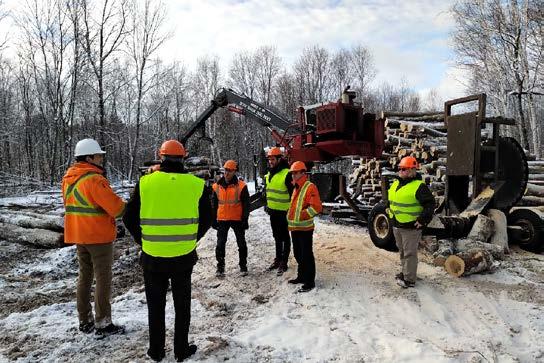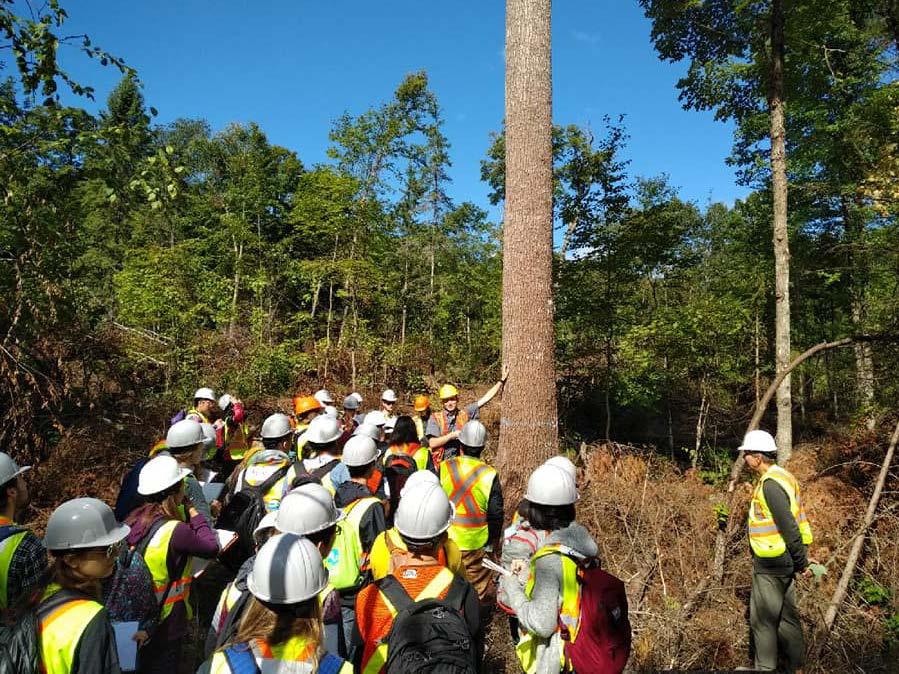
7 minute read
2020 December Forest Seminar
Climate Change and Biodiversity focus of December 2020 Forest Seminar (Part 1)
By Tony Bull, President of the Eastern Ontario Model Forest, and Renfrew County Chapter
Advertisement
Introduction
The twin themes of the December Seminar (hosted by the Eastern Ontario Model Forest (EOMF) and the Ottawa Valley Section of the Canadian Institute of Forestry (CIF)) were planetary threats due to humaninduced climate change on one hand and the serious loss of biodiversity evidenced by enhanced extinction rates on the other hand. In the next issue I will explore the seriousness of these challenges and some possible bases for optimism that I have observed in my reading. The Seminar featured three speakers addressing these two urgent environmental challenges.
The Climate Change Challenge
John Pedlar, Canadian Forest Service Forest Landscape Biologist spoke of future climate scenarios and what adaptation can be done to ensure future intact forests. He said that over the last 100 years we have seen already a one-degree centigrade increase in mean temperature. Looking forward, in a low emission scenario we could see an increase of one to two degrees above the current average. In a high emission scenario, it could be as much as five to nine degrees higher. With the low emission scenario there would be an increase in precipitation; perhaps 9%. The high emission scenario would bring a big increase in precipitation in the north. But even with higher precipitation the water balance would be drier for Canada due to higher evapo-transpiration rates. Eastern Ontario could be quite dry by the end of the century. There would also be an increase in weather events such as wind and droughts; late spring frosts; that is, less predictability. In Eastern Ontario, a changed fire zone could make it challenging to keep trees on the landscape. Moreover, forest pests will migrate northwards (as they are doing now). Anticipating changes in climate it is possible to have assisted migration of species northward or encouraging modest range expansions. It is necessary to examine where seed sources should be accessed for planting. It is estimated that a four-degree northward movement or a two-degree southward movement would result in a 90% growth response. His work suggests that, on average, seed sources can be moved approximately five degrees northward (i.e., several hundred kilometers in the relatively flat terrain of eastern Canada) before exhibiting growth declines >10% relative to the local seed source.
Forests as a positive influence on climate change
Malcolm Cockwell is the manager of the 40 thousandhectare Haliburton Forest and Wildlife Reserve on the south west border of Algonquin Park. The overriding mission is “to uphold a strong land ethic”. He said that their foresters are united in managing for many benefits; wildlife, water, biodiversity, and so on. The forest is certified to the Forest Stewardship Council® sustainable forest certification system. Of the 10 principles that are adhered to, principle six addresses the all-important biodiversity conservation role of the forest.
Winter Forestry Tour Photo Credit: Haliburton Forest and Wildlife Reserve Ltd.
Within that context the management of the forest seeks to unlock the value of the many services that the forest provides; recreation, education, research, forest products as examples. What Malcolm described was the unlocking of the benefit of carbon capture and storage that arises from forest growth.
continued next page ...
In 2017, Haliburton Forest signed with Bluesource, a California-based company that works with managed forests such as Haliburton, to bring their carbon offsets to the market.
How does it work? For their Improved Forest Management (IMF) agreement the payment is based on the degree to which a forest is managed at a stocking level higher than a normal “base” level that is typical of the forest region in which the forest is situated. It is a long-term agreement; typically ranging from 40 to 100 years. One advantage of this long-term horizon is that a forest under agreement is protected from competing land uses such as housing development or golf course development Malcolm made clear that to engage in this type of agreement is a huge commitment beyond the usual length of time for such arrangements. It requires extra management activities such as permanent sample plots in order to have detailed information on all aspects of impacts of forest management prescriptions and growth over time. Payment for entering into the agreement and commitment would be an upfront payment based on the total area of forest to be covered by it. Forests are both emitters of carbon dioxide and act as sinks. The forest managers are taking steps to reduce carbon dioxide emissions through steps such as limiting the size of landings (which emit methane) and making sure they are reforested. They are also experimenting with lower emission equipment.
Biodiversity and Farming
The Food and Agricultural Organization (FAO) report on the State of the World’s Biodiversity for Food and Agriculture describes a worrying decline in biodiversity that both supports agriculture and provides essential ecological services. The report outlines issues such as loss and degradation of forest and aquatic ecosystems. On the other hand, the report also acknowledges that there is an increase in biodiversity-friendly farming practices in many parts of the world. Bob Dobson of Dobson Farms north of Cobden has been practicing biodiversity-friendly agriculture for the last 50 years. His great grandfather started the farm in the 1830s. It has been in the family ever since. He remembers his father clearing fencerows prior to the 1970s in order to create more open land and make farming more efficient. At that time there were support programs encouraging such practice. Bob remembers feeling uncomfortable at this practice. Bob showed pictures of the farm and house in the mid 1900s and after he had engaged in a multiyear tree and shrub planting program. He did this planting to diversify the farm environment as part of his change to grass fed beef without the use of chemicals and growth hormones. The change between the two aerial photos is dramatic.
In the original photo the farm buildings and house had no trees near them, and the surrounding land was bare. In the latter photo trees were abundant around the farm buildings and dotted the landscape as well.
Tree Marking Tour Photo Credit: Haliburton Forest and Wildlife Reserve Ltd.

To date he has planted over thirty thousand trees including some wildlife shrubs. From 1980 to 2010, he planted 1000 trees per year usually in the first week of May. The seedlings, from the Ferguson Forest Centre in Kemptville,include a number of varieties of deciduous and conifers trees.
There are now over two miles of upland shelter belts, two to five rows of trees wide and planted across the prevailing wind. These shelter belts slow down the wind and keep more of the moisture (snow and rain) on the farm. Also, the trees provide windbreak shelter for the livestock and a home for wildlife (birds, snakes, fox etc.) which help control insects and rodents on the farm. The shelter belts consist of 7 species: spruce, cedar, pine, ash, oak, butternut and black walnut. To solve the problem of decreasing quantity and quality of water, Bob continued fencing the cattle out of the stream and adjacent land over the last few years and a reservoir was dug. The cattle still needed a source of

Treed Riparian Buffer drinking water, so an in-line gravity trough system was constructed in 1987 to give them access to water while restricting their access to the waterway. Bob planted approximately one mile of lowland riparian buffer strips on each side of the 2 streams crossing the farm. These two miles of buffer strip plantings provides excellent habitat for many species of wildlife, while at the same time slows down or stops runoff from the fields entering the stream. He finds that the trees as they grow, crack open the heavy clay soil, (sort of like creating a sponge) and more easily allowing the penetration after a heavy rainfall and runoff from the hay or pasture fields.
He has also reduced his herd size and feeds them exclusively on grass and cut hay from his fields; using no fertilizer or chemicals.
Bob is convinced that he now has a much better environmental footprint on his farm. The Ontario Cattlemen’s Association was convinced too. In 1994 Bob was the first recipient of their Stewardship Award in recognition of Bob’s projects on the farm to enhance and protect waterways as well as create bird and wildlife habitat.
As a final comment, Bob described how he has seen the local climate change over the past decades. He feels that his tree planting is a positive measure to slow down the impact of this challenge. So, what Bob Dobson does on his farm, both in terms of his biodiversity friendly approach, and in being a place of demonstration to others is an ideal way to make progress that goes beyond the boundaries of his farm. Similarly, as described by Malcolm Cockwell, the Haliburton Forest, with its strong environmental vision is also a show piece for its many visitors, both recreational and educational.
In these two examples what is done on the land becomes a lesson for many people leading to a more widespread informed and committed populace that support and do the right thing for our threatened environment.
Part 2 will be continued in the June 2021 Issue of The
Ontario Woodlander ❧










